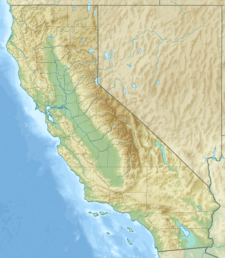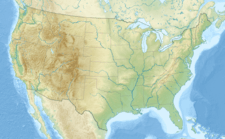Lilliput Glacier facts for kids
Quick facts for kids Lilliput Glacier |
|
|---|---|
| Type | Mountain glacier |
| Location | Mount Stewart, Sequoia National Park, Tulare County, California, U.S. |
| Coordinates | 36°34′53″N 118°33′07″W / 36.58139°N 118.55194°W |
| Area | 0.05 km2 (0.019 sq mi) |
| Length | .16 km (0.099 mi) |
| Terminus | Talus |
| Status | Retreating |
Lilliput Glacier is a very special glacier located in the Sierra Nevada mountains of California. It holds the record for being the smallest named glacier in this mountain range. Imagine a giant block of ice that slowly moves! That's what a glacier is.
This tiny glacier covers an area of about 0.05 square kilometers, which is roughly the size of 12 acres. To give you an idea, that's like 48 regular house lots in a neighborhood. It sits on the shaded, north-facing side of Mount Stewart. This makes it the southernmost named glacier in the entire United States!
Contents
What is Lilliput Glacier?
Lilliput Glacier is unique because of its small size. It's like the little sibling of all the other glaciers. Even though it's small, it's still a true glacier. This means it's a large, long-lasting body of ice that forms on land and moves slowly due to its own weight.
Its small size makes it very sensitive to changes in temperature. It shows us how even the smallest parts of our environment can be affected by warmer weather.
Where is Lilliput Glacier Located?
Lilliput Glacier is found high up in the Sierra Nevada mountains. Specifically, it's on Mount Stewart, which is inside the beautiful Sequoia National Park. This park is famous for its giant trees and amazing natural beauty.
The glacier is on a cliff that faces north. This is important because north-facing slopes get less direct sunlight. This helps the ice stay frozen, even during warmer months. It's also the southernmost named glacier in the United States. This means it's located further south than any other named glacier in the country.
Why Are Glaciers Important?
Glaciers are like giant frozen rivers. They are very important for many reasons.
- Fresh Water Storage: Many glaciers store huge amounts of fresh water. When they melt slowly, they provide water for rivers and streams. This water is used by people, animals, and plants.
- Climate Clues: Glaciers are also like natural thermometers. They can tell us a lot about Earth's climate history. Scientists study glaciers to understand how temperatures have changed over thousands of years.
- Ecosystems: The meltwater from glaciers creates unique habitats for plants and animals.
What Does "Retreating" Mean?
The Infobox for Lilliput Glacier says its status is "Retreating." This means the glacier is getting smaller. When a glacier retreats, it melts faster than new snow can fall and turn into ice. This causes the end of the glacier, called the terminus, to move backward.
Many glaciers around the world are retreating. This is often due to warmer temperatures. When glaciers retreat, it can affect water supplies and change the landscapes around them. Lilliput Glacier's retreat is a sign of how even small changes in climate can impact our natural world.
How Do Glaciers Form?
Glaciers form over many years in places where more snow falls in winter than melts in summer. Here's how it happens:
- Snow Accumulation: First, a lot of snow piles up.
- Compaction: As more snow falls, the layers below get squashed. The weight of the new snow presses down on the old snow.
- Ice Formation: This pressure squeezes out the air from the snow. The snow crystals then change and become denser, turning into a special type of ice called firn.
- Glacier Ice: Over time, the firn gets even more compressed and turns into solid, blue glacier ice. Once the ice is thick enough, it starts to flow slowly downhill due to gravity.
Lilliput Glacier, despite its small size, formed in this same way, showing the power of snow and ice over time.



